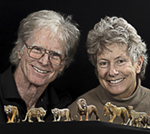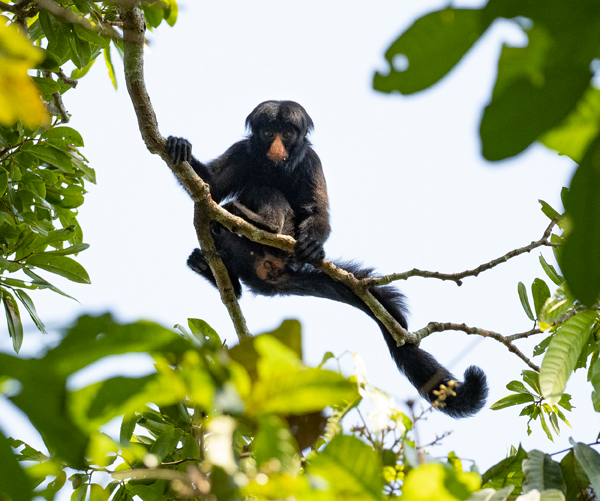
White-nosed Saki Monkey
Amazonia in Brazil
September 2019
Scouting Trip Report
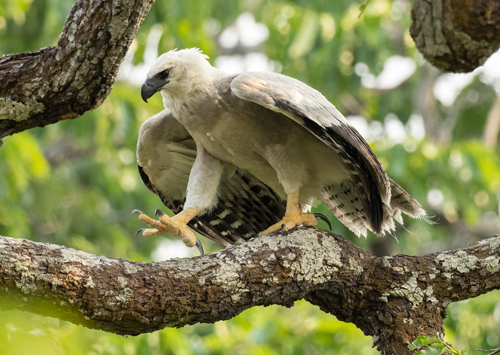
Harpy Eagle immature - check out the size of those feet!
Photos in this report are by both Joe and Mary Ann McDonald
The Amazon is vast, covering parts of Brazil, Ecuador, Peru, and parts of other northern South American countries. I've been there before, via Ecuador, but that experience wasn't very satisfying as the trip wasn't geared for photography. This one was, so Mary and I decided to do a Scouting Trip, accompanied by two friends who had just completed our September Pantanal trip.
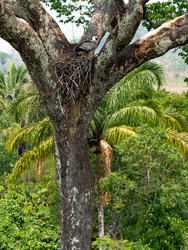
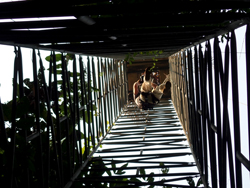
Harpy Eagle nest, 110 ft off the ground; Joe being pulled up into the tower.
The area had several attractions, and chief among those was a Harpy Eagle nest where a scaffold/blind was located, just 15-20 yards away from the nest, and about an equal distance from where a vehicle could park - imagine that! Several species of monkeys were also in the area, and we hoped to photograph all of them. Tapirs, Ocelots, and various birds were other potential subjects, but having been in the Amazon before, I knew that shooting here can be difficult. We hoped for the best.
We had six days in the field, and I must admit that when we arrived at our lodge (with very, very nice accommodations) Mary and I wondered if six days would be too much, and whether or not we'd be bored after a day or so. We were not! As it turned out, each day was filled with activity, and the trip proved very productive, although there were some hickups - which I'll cover later for those interested.
At any rate, Mary and I almost always insist on doing a Scouting Trip before we take a group to a location, and every responsible tour leader should do so. Sadly, many do not, and the horror stories we later hear serve to validate our decision. This Scouting Trip was a good example of this, too, as we could see where modifications or arrangements should be made for making a real Photo Tour extremely successful. I won't go into those, as we'll have those factors worked out before we do a Tour.

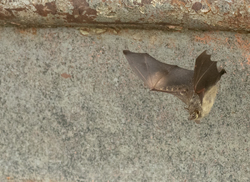
Long-nosed River Bats roosted on the side of a derelict ship. One flew off just as I fired.
Case in point, was the Harpy Eagle tower. While all of us were anxious to photograph the Harpy Eagle, I don't think any of us were prepared for the tower, which rose about 33 meters, about 110 feet, into the air. Looking up, it was a bit intimidating, and the height was too much for one of our friends. I'd make it clear, as I'm doing now, that we're talking about a big tower!
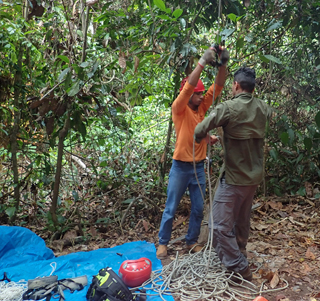 Mary and I were the first to do the tower, and it was actually quite easy. Three workers expertly man a pulley rope system, so all we needed to do was sit in a climbing harness and enjoy the view as we were pulled up into the tower. When we reached the top, we found the platform extremely secure, and we were comfortable almost immediately, with the immature Harpy Eagle about 40 feet away.
Mary and I were the first to do the tower, and it was actually quite easy. Three workers expertly man a pulley rope system, so all we needed to do was sit in a climbing harness and enjoy the view as we were pulled up into the tower. When we reached the top, we found the platform extremely secure, and we were comfortable almost immediately, with the immature Harpy Eagle about 40 feet away.
The immature could fly, and there was always the chance that the bird could have been perched and out of sight in one of several trees that were nearby but we were lucky, the bird was perched on a limb just above the nest. During the day the bird did fly off, but the eagle landed on a tree that also provided great views, including those as the bird lost its footing and hung, upside down, until it flapped itself upright again.
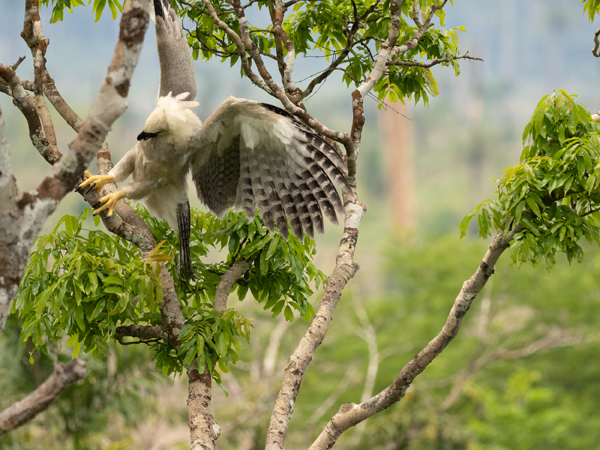
Harpy Eagle immature losing its balance after landing on a nearby tree.
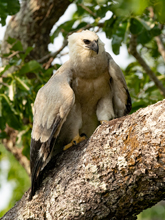
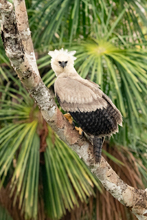
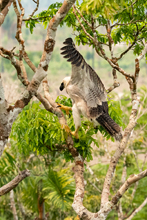
We spent the day here, but right before noon we had a fright. The day before, on our first afternoon here, a serious thunderstorm rolled in while we were on a river looking for monkeys. Recognizing the potential danger of being on the water during a storm we aborted our boat ride, and reached our lodge right before it began to rain. Now, while we were high on a steel tower, we watched as dark clouds once again gathered on the horizon, and we worried that we'd be marooned up there in a lightning storm. There was no escape for us, as our guide who does much of the rope work was back at the lodge, an hour away. We had our other guide (two stayed below while we were in the tower) call the lodge and request he come immediately, bringing our two friends with us so they could see the eagle.
He returned as instructed, and luckily the storm dissipated, and we spent the rest of the afternoon in the tower while our friends watched the birds from below. At the end of the day the immature eagle flew to a tree mostly hidden behind the nest tree, and with that we left the platform.
The following day one of our participants, Phil, decided he'd try the tower as well, and the three of us spent the day on the platform. By a bit of positioning, all of us had a comfortable position and enough room on the 5x5 platform. When we arrived the immature was still in the tree where we left it the day before, but we hoped the bird would show itself. Our guides told us that the immature had not been fed by a visiting adult for at least five days, and we hoped one would fly in with a kill.
One did, suddenly appearing between trees and carrying what looked like a monkey in the brief glimpse we had before the bird landed in the immature eagle's tree. The adult was just barely in view, and we hoped it would fly to the nest tree with the kill. It did not, but instead left the kill on a branch. The immature eventually flew there, providing us with very limited views of its back end and no real photo ops, while giving its begging call the entire time as if it wanted to be fed. Eventually the bird turnedand faced us, and by dropping down to the platform level with my camera (I used the very handy flip out screen for focusing and composing) I got some shots of the immature with the kill.
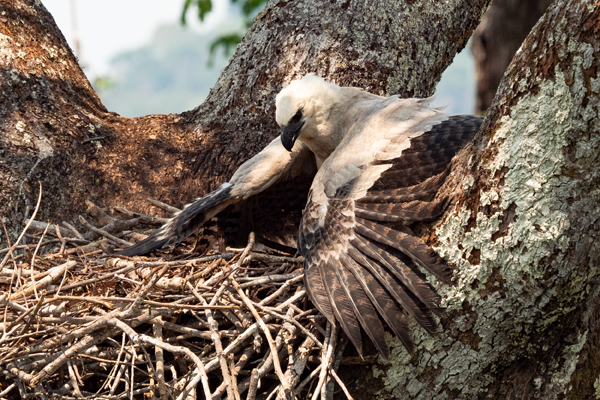
Harpy Eagle immature 'mantling' its kill after returning to the nest.
Suddenly, the bird took off, and flew directly to the nest with the kill in its talons! I was completely out of position since I was still positioned for a low shot, but Mary and Phil got some great shots as the bird flew straight at them. The bird landed, and for the rest of the day we photographed the bird as it fed on the nest.
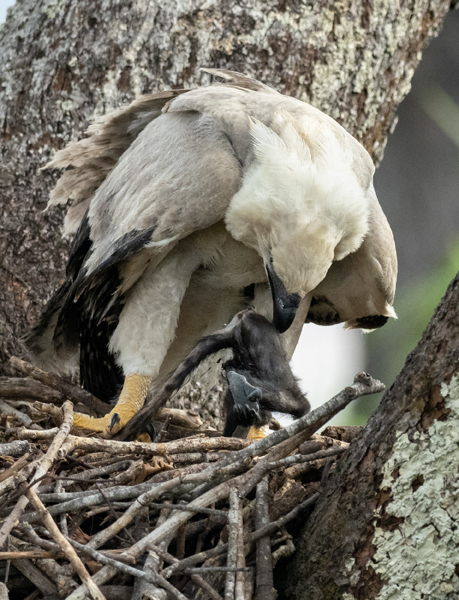
Harpy Eagle immature - eating the remains of a Spider Monkey!
We still hoped that an adult would show up at the nest, and perhaps one would have but we had a problem. Our tower can, in theory, accommodate 5 or 6 people, as the roof of our platform serves as a second viewing area. Unfortunately, the tower was booked for another visitor (a last minute and very disappointing bit of news for us) and the visitor and a guide had joined us on the platform. Now, with 5 people on the tower, and two of those (the interlopers) moving about to get different angles, the tower often shook, not enough to scare us, but enough to make doing any video impossible.
By early afternoon that visitor had had enough and decided to leave. The exit was through the floor of our platform, so we had to rearrange ourselves and our gear to allow the trap door to rise, and for the visitor and guide to descend. While all this was going on, an adult Harpy Eagle flew by! The immature immediately responded, turning and calling, but the adult continued on and disappeared.
To be honest, I can't be certain that the adult would have flown in, but I suspect it was approaching to do so. The activity destroyed that chance. On our future tour, you can be sure I'll insist that our group is the only one at the tower!
We also spent time in a Monkey observation platform that was also above the surrounding tree canopy. This one consisted of planks set as a platform in the crown of a tree. Nearly as high as the tower, we reached it by being pulled up by pulleys, but without the psychological comfort of being surrounded by a scaffold as we were doing so. Once on the platform we decided it wasn't for everyone, as there were no guard rails. While Mary and I detached ourselves from the safety rope, one of our friends, who did the platform with a guide while we were in the tower, stayed roped in the entire time. Obviously, this excursion would not be for everyone -- it could be terrifying.
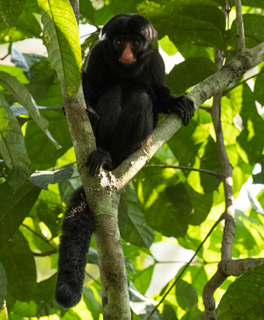
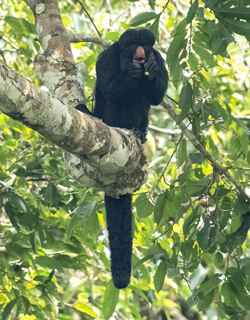
White-nosed Saki Monkeys
While we were hoping for monkeys none arrived, and wishing to get a final boat ride before we left the lodge and the area for a final shoot at another location, we stayed for only a few hours. Our friends joined us as we descended, and just as we reached our truck to drive on to the river a large troop of White-nosed Saki Monkeys arrived! The monkeys were high in the canopy and were probably visible, and shootable, from the platform, but we did manage some decent shots from ground level. Nonetheless, I regretted that I'd left the platform although, two days earlier, one of our friends spent the entire morning there, with no real luck. That's wildlife photography!
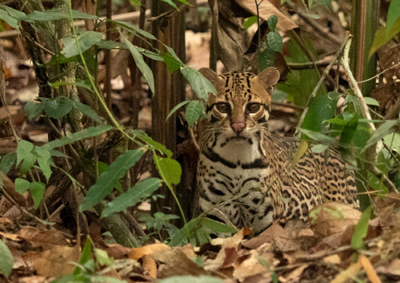 When we were not in a tower we'd spend our time either at a floating platform positioned for photographing an Ocelot that came to some bait during the day, or floating the river looking for monkeys and birds. Phil spent an entire morning on the Ocelot platform and enjoyed over an hour's shooting with the cat, while our other friend spent an entire morning at the same spot with nothing appearing, except the biting bugs. All four of us spent the first morning here, and we had a brief shooting opportunity with a somewhat shy cat, shown above.
When we were not in a tower we'd spend our time either at a floating platform positioned for photographing an Ocelot that came to some bait during the day, or floating the river looking for monkeys and birds. Phil spent an entire morning on the Ocelot platform and enjoyed over an hour's shooting with the cat, while our other friend spent an entire morning at the same spot with nothing appearing, except the biting bugs. All four of us spent the first morning here, and we had a brief shooting opportunity with a somewhat shy cat, shown above.
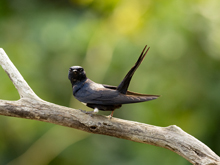
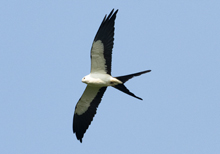
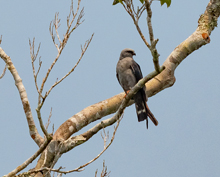
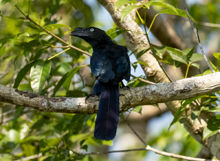
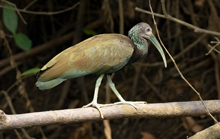
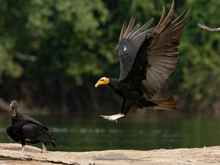
White-banded Swallow; Swallow-tailed Kite; Plumbeous Kite
Great Ani; Green Ibis; Greater Yellow-headed Vulture
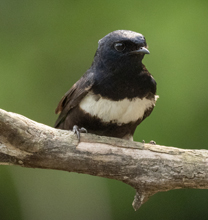
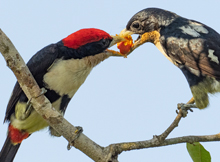
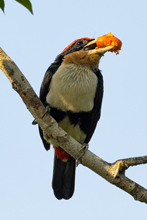
White-banded Swallow; Black-girdled Barbet
Our boat excursions were interesting. Our primary focus was monkeys and a unique bird called a Hoatzin. The Hoatzin is as near as you'll ever come to an Archaeopteryx, the missing link bird that lived during the age of Dinosaurs, specifically in the Jurassic period. The Archaeopteryx had feathers, and teeth, and, without the feathers would look just like any other small dinosaur of that period.
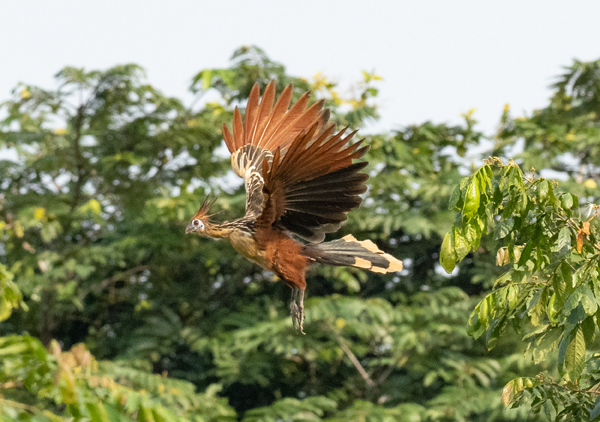
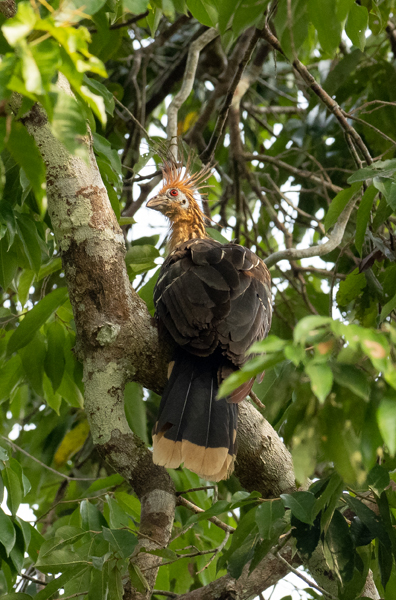
Hoatzins don't have teeth, as no bird does, but it is unique in having claws on what are essentially fingers (or digits) on the wings of the chicks. They use these claws for climbing, and if you Google Hoatzin you can watch two videos that show the chicks doing exactly that.
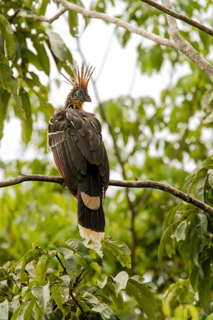 We found the Hoatzins extremely wary, flying away from the river side trees while we were still quite a distance away. Luckily some didn't go far, and we managed some shots as adults clambered about in the trees before, inevitably, flying deeper into the forest. We wondered if these protected birds (there is no legal hunting in Brazil) are hunted, and our guide wondered if birds were killed and used as bait for fishing. While challenging, we did manage shots, and Phil nailed a good one when he was returning from the Ocelot platform.
We found the Hoatzins extremely wary, flying away from the river side trees while we were still quite a distance away. Luckily some didn't go far, and we managed some shots as adults clambered about in the trees before, inevitably, flying deeper into the forest. We wondered if these protected birds (there is no legal hunting in Brazil) are hunted, and our guide wondered if birds were killed and used as bait for fishing. While challenging, we did manage shots, and Phil nailed a good one when he was returning from the Ocelot platform.
Left - Phil's Hoatzin
We saw, and photographed, three species of Monkey - Wooly, White-nosed Saki, and Brown-capped Capuchin. The Saki is endangered, but it is found here and we had reasonable luck. On our last morning, we had an entire group along the river, with several climbing down vines to take a drink. Our only Wooly presented a good view, but was back-lighted against a western sky. We were hoping to get Spider Monkeys as well, and a photographer who was there a few weeks earlier showed me a great shot he made of this species. We weren't that lucky.
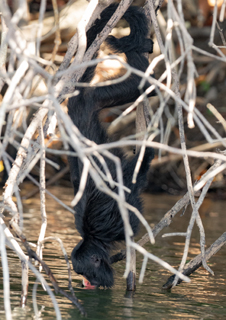
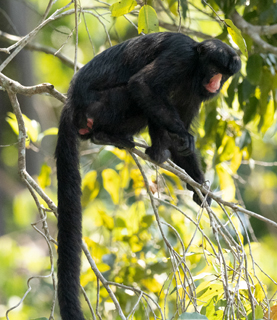
White-nosed Saki Monkey
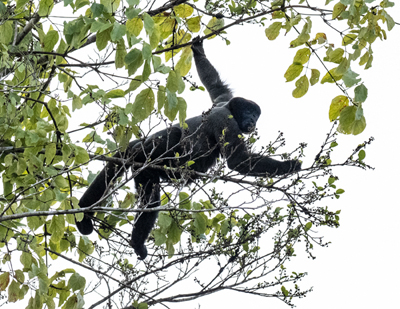
Wooly Monkey
I brought a fair amount of flash gear for jungle photography, but we were so busy, and tired by the end of the day, that I didn't have the energy to spend much time in the jungle at night. Our lodge was in a working ranch, and there was no likely looking jungle habitat within an easy walking distance, so I had an excuse. On our last night, I did go out with our guides for a thirty-minute excursion that lasted about an hour, and required a ten minute drive to reach the forest. One of our guides, the local hire, was as close to a Tarzan character that I've ever seen, displaying incredible energy. He led our hike, and commented that we really needed three hours for a good hike -- and this from a guy that has been climbing towers and trees, manning boats, and driving the truck, continuously working for the last five days!
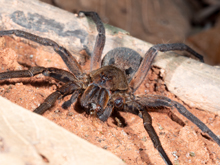
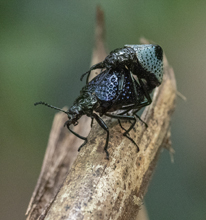
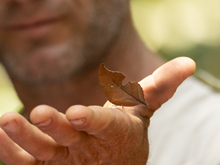
Wolf Spider with the macro twin lights; Mating Beetles via Focus Stacking; Leaf-mimic Butterfly
Spiders, wierd scorpion-like Arachnids called Tailless Whipscorpions, and various insects were common, and I shot several. For some I used my 1200mm combination (300mm w 2X converter) and on-camera flash, and for others the 60mm macro with the Twin Light sytem -- all Olympus gear. In the close confines of the jungle it was difficult to get back 5.5 feet to achieve focus with the 1200mm, as inevitably a tree would seem to block my path. Using that lens may have been the wrong choice for the conditions, but I did get a great Focus Stacking shot, using just our guide's flashlight as the only light source, of a large Wolf Spider. When we return, we'll make sure that we'll do more jungle night walks for those that are interested. It would be rewarding.
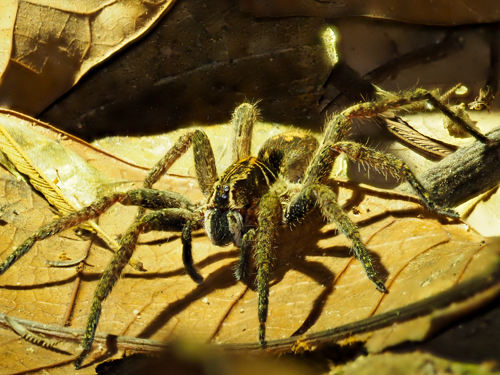
Wolf Spider with Focus Stacking, with 1200mm!
The value of doing a Scouting Trip is illustrated by the following story. We were a group of 4, Mary, me, and two folks who did our scouting trip. We were met at the airport by a driver/guide in a pickup, a crew cab. Our luggage went in the back, and we crammed into the cab. It was tight and uncomfortable, and 3 of us were relatively small – big or heavy guys would have been in serious trouble.
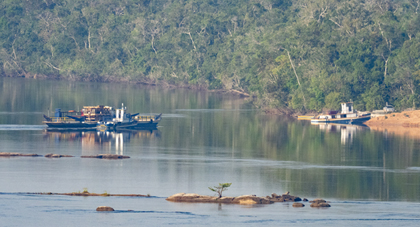
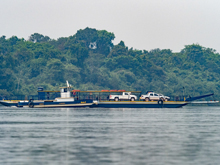 If we missed the ferry – the last leg of the journey where a 20 minute ride completes the trip to the lodge – we would have the option of either staying at a hotel 30 or so minutes back-tracking, or taking a small boat over the 900 meter wide river and then a motor cycle could transport us, one at a time, to the lodge! We were not going to do that. Luckily, as we started the trip our driver said we’d have to hurry, so we didn’t stop and arrived about 3 minutes before the last ferry of the day crossed the river. With that major obstacle covered we were very happy and excited, our luck started off great.
If we missed the ferry – the last leg of the journey where a 20 minute ride completes the trip to the lodge – we would have the option of either staying at a hotel 30 or so minutes back-tracking, or taking a small boat over the 900 meter wide river and then a motor cycle could transport us, one at a time, to the lodge! We were not going to do that. Luckily, as we started the trip our driver said we’d have to hurry, so we didn’t stop and arrived about 3 minutes before the last ferry of the day crossed the river. With that major obstacle covered we were very happy and excited, our luck started off great.
That luck continued through the trip, and we succeeded in getting all the species we hoped to photograph, with the exception of the Spider Monkey.
When we finished the trip, our plan was to leave after lunch, visit a Macaw nesting/roosting spot on the way back, stay overnight at a local hotel, and then, the following morning, either revisit the macaws or continue on to the airport for our early afternoon flight.
After crossing on the ferry and driving for 15 minutes or so, our pickup truck began to die. The electrical system seemed to fail. We got the car working by popping the clutch, with our driver/guide pushing and steering, going backwards while doing so. Had we been in the bottom of a dip we’d have been in real trouble, since the vehicle couldn’t have been pushed to get the clutch popped. We limped on to the nearest town and after 2 hours or so got a new battery installed, and the car worked fine. For a time.
We decided to pass completely on the macaws, as we didn’t have complete confidence in the vehicle and felt it more prudent to get to the city, stay overnight, and make our flight the following afternoon.
We continued on, heading towards our final destination, and day became night. We passed a few little towns. We were within 80km of the city, just an hour or so away, when our headlights began to dim, seriously dim, and the car began to stutter. We were in the middle of nowhere – no lights, a minimal berm or shoulder to the road, and miles from anywhere. By chance, we had just passed the only truck stop/restaurant we’d seen for over an hour, and our driver said he wanted to turn back, and not get stuck out here. We heartily agreed, and he made the U-turn with us worried to death that we’d stall and get T-boned by a truck. We got to the restaurant where, via WhatsApp, the driver connected with the office. A car was to be sent, but after it didn’t arrive I asked the driver to call and confirm, and we were told the driver decided not to go! So the process started again, with a promise, this time, that another vehicle was coming – two cars, this time. Meanwhile, the restaurant closed, but the owner was kind enough to keep the lights on outside, where we waited, among the bugs.
The vehicles finally arrived, and we reached the city at 11:30PM, in one pickup truck but with an uncovered bed for our luggage that could have been an issue had there been rain. Fortunately the sky stayed clear, and we filed away more data to fine-tune our future trip to this incredible area.
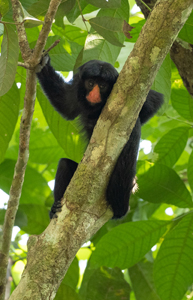
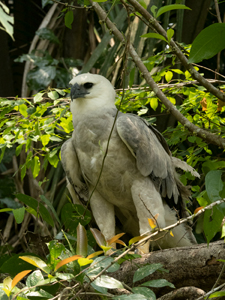
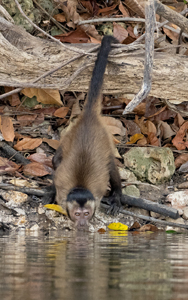
White-nosed Saki Monkey; immature Harpy Eagle; Capuchin Monkey
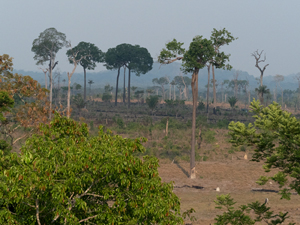
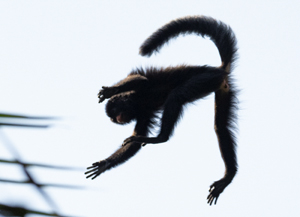
Brazilain Nut Trees - the only trees left after clearing forest and jungle; Saki Monkey
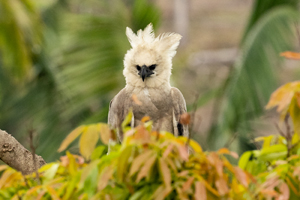
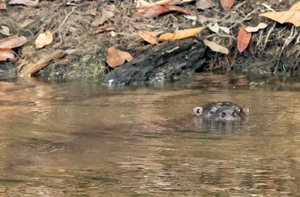
Harpy Eagle immature; Neotropical Otter
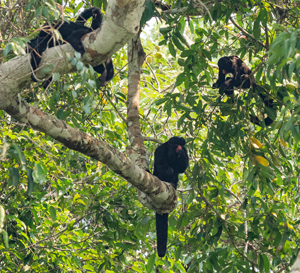
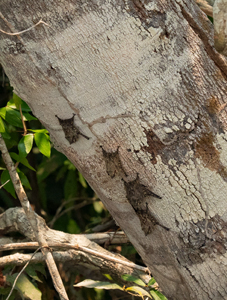
White-nosed Saki Monkey; Long-nosed River Bats
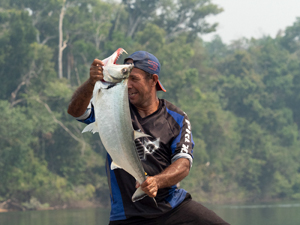 .
.
Cachorra, Hydrolycus scomberoides
Look at the size of those teeth - be careful!
We will be doing our first Photo Tour to the Amazon of Brazil in 2021,
following one of our Pantanal Photo Tours. If you are not afraid of
heights, come join us! The wildlife is unique!
Why you should travel with us
Testimonials
Check out the prices -
Olympus Official Store
Featured on ShotKit - read the interview
Join us on Facebook at: Follow Hoot Hollow
Office Phone: (717) 543-6423
Or FAX us at: (717) 543-5342
Mary and Joe are proud to endorse the Photo Retailer that has
done the absolute most in supporting nature photography in all
its facets ---

Check out the Monthly Specials
from Hunt's

White-nosed Saki Monkey
Amazonia in Brazil
September 2019
Scouting Trip Report

Harpy Eagle immature - check out the size of those feet!
Photos in this report are by both Joe and Mary Ann McDonald
The Amazon is vast, covering parts of Brazil, Ecuador, Peru, and parts of other northern South American countries. I've been there before, via Ecuador, but that experience wasn't very satisfying as the trip wasn't geared for photography. This one was, so Mary and I decided to do a Scouting Trip, accompanied by two friends who had just completed our September Pantanal trip.


Harpy Eagle nest, 110 ft off the ground; Joe being pulled up into the tower.
The area had several attractions, and chief among those was a Harpy Eagle nest where a scaffold/blind was located, just 15-20 yards away from the nest, and about an equal distance from where a vehicle could park - imagine that! Several species of monkeys were also in the area, and we hoped to photograph all of them. Tapirs, Ocelots, and various birds were other potential subjects, but having been in the Amazon before, I knew that shooting here can be difficult. We hoped for the best.
We had six days in the field, and I must admit that when we arrived at our lodge (with very, very nice accommodations) Mary and I wondered if six days would be too much, and whether or not we'd be bored after a day or so. We were not! As it turned out, each day was filled with activity, and the trip proved very productive, although there were some hickups - which I'll cover later for those interested.
At any rate, Mary and I almost always insist on doing a Scouting Trip before we take a group to a location, and every responsible tour leader should do so. Sadly, many do not, and the horror stories we later hear serve to validate our decision. This Scouting Trip was a good example of this, too, as we could see where modifications or arrangements should be made for making a real Photo Tour extremely successful. I won't go into those, as we'll have those factors worked out before we do a Tour.


Long-nosed River Bats roosted on the side of a derelict ship. One flew off just as I fired.
Case in point, was the Harpy Eagle tower. While all of us were anxious to photograph the Harpy Eagle, I don't think any of us were prepared for the tower, which rose about 33 meters, about 110 feet, into the air. Looking up, it was a bit intimidating, and the height was too much for one of our friends. I'd make it clear, as I'm doing now, that we're talking about a big tower!
 Mary and I were the first to do the tower, and it was actually quite easy. Three workers expertly man a pulley rope system, so all we needed to do was sit in a climbing harness and enjoy the view as we were pulled up into the tower. When we reached the top, we found the platform extremely secure, and we were comfortable almost immediately, with the immature Harpy Eagle about 40 feet away.
Mary and I were the first to do the tower, and it was actually quite easy. Three workers expertly man a pulley rope system, so all we needed to do was sit in a climbing harness and enjoy the view as we were pulled up into the tower. When we reached the top, we found the platform extremely secure, and we were comfortable almost immediately, with the immature Harpy Eagle about 40 feet away.
The immature could fly, and there was always the chance that the bird could have been perched and out of sight in one of several trees that were nearby but we were lucky, the bird was perched on a limb just above the nest. During the day the bird did fly off, but the eagle landed on a tree that also provided great views, including those as the bird lost its footing and hung, upside down, until it flapped itself upright again.

Harpy Eagle immature losing its balance after landing on a nearby tree.



We spent the day here, but right before noon we had a fright. The day before, on our first afternoon here, a serious thunderstorm rolled in while we were on a river looking for monkeys. Recognizing the potential danger of being on the water during a storm we aborted our boat ride, and reached our lodge right before it began to rain. Now, while we were high on a steel tower, we watched as dark clouds once again gathered on the horizon, and we worried that we'd be marooned up there in a lightning storm. There was no escape for us, as our guide who does much of the rope work was back at the lodge, an hour away. We had our other guide (two stayed below while we were in the tower) call the lodge and request he come immediately, bringing our two friends with us so they could see the eagle.
He returned as instructed, and luckily the storm dissipated, and we spent the rest of the afternoon in the tower while our friends watched the birds from below. At the end of the day the immature eagle flew to a tree mostly hidden behind the nest tree, and with that we left the platform.
The following day one of our participants, Phil, decided he'd try the tower as well, and the three of us spent the day on the platform. By a bit of positioning, all of us had a comfortable position and enough room on the 5x5 platform. When we arrived the immature was still in the tree where we left it the day before, but we hoped the bird would show itself. Our guides told us that the immature had not been fed by a visiting adult for at least five days, and we hoped one would fly in with a kill.
One did, suddenly appearing between trees and carrying what looked like a monkey in the brief glimpse we had before the bird landed in the immature eagle's tree. The adult was just barely in view, and we hoped it would fly to the nest tree with the kill. It did not, but instead left the kill on a branch. The immature eventually flew there, providing us with very limited views of its back end and no real photo ops, while giving its begging call the entire time as if it wanted to be fed. Eventually the bird turnedand faced us, and by dropping down to the platform level with my camera (I used the very handy flip out screen for focusing and composing) I got some shots of the immature with the kill.

Harpy Eagle immature 'mantling' its kill after returning to the nest.
Suddenly, the bird took off, and flew directly to the nest with the kill in its talons! I was completely out of position since I was still positioned for a low shot, but Mary and Phil got some great shots as the bird flew straight at them. The bird landed, and for the rest of the day we photographed the bird as it fed on the nest.

Harpy Eagle immature - eating the remains of a Spider Monkey!
We still hoped that an adult would show up at the nest, and perhaps one would have but we had a problem. Our tower can, in theory, accommodate 5 or 6 people, as the roof of our platform serves as a second viewing area. Unfortunately, the tower was booked for another visitor (a last minute and very disappointing bit of news for us) and the visitor and a guide had joined us on the platform. Now, with 5 people on the tower, and two of those (the interlopers) moving about to get different angles, the tower often shook, not enough to scare us, but enough to make doing any video impossible.
By early afternoon that visitor had had enough and decided to leave. The exit was through the floor of our platform, so we had to rearrange ourselves and our gear to allow the trap door to rise, and for the visitor and guide to descend. While all this was going on, an adult Harpy Eagle flew by! The immature immediately responded, turning and calling, but the adult continued on and disappeared.
To be honest, I can't be certain that the adult would have flown in, but I suspect it was approaching to do so. The activity destroyed that chance. On our future tour, you can be sure I'll insist that our group is the only one at the tower!
We also spent time in a Monkey observation platform that was also above the surrounding tree canopy. This one consisted of planks set as a platform in the crown of a tree. Nearly as high as the tower, we reached it by being pulled up by pulleys, but without the psychological comfort of being surrounded by a scaffold as we were doing so. Once on the platform we decided it wasn't for everyone, as there were no guard rails. While Mary and I detached ourselves from the safety rope, one of our friends, who did the platform with a guide while we were in the tower, stayed roped in the entire time. Obviously, this excursion would not be for everyone -- it could be terrifying.


White-nosed Saki Monkeys
While we were hoping for monkeys none arrived, and wishing to get a final boat ride before we left the lodge and the area for a final shoot at another location, we stayed for only a few hours. Our friends joined us as we descended, and just as we reached our truck to drive on to the river a large troop of White-nosed Saki Monkeys arrived! The monkeys were high in the canopy and were probably visible, and shootable, from the platform, but we did manage some decent shots from ground level. Nonetheless, I regretted that I'd left the platform although, two days earlier, one of our friends spent the entire morning there, with no real luck. That's wildlife photography!
 When we were not in a tower we'd spend our time either at a floating platform positioned for photographing an Ocelot that came to some bait during the day, or floating the river looking for monkeys and birds. Phil spent an entire morning on the Ocelot platform and enjoyed over an hour's shooting with the cat, while our other friend spent an entire morning at the same spot with nothing appearing, except the biting bugs. All four of us spent the first morning here, and we had a brief shooting opportunity with a somewhat shy cat, shown above.
When we were not in a tower we'd spend our time either at a floating platform positioned for photographing an Ocelot that came to some bait during the day, or floating the river looking for monkeys and birds. Phil spent an entire morning on the Ocelot platform and enjoyed over an hour's shooting with the cat, while our other friend spent an entire morning at the same spot with nothing appearing, except the biting bugs. All four of us spent the first morning here, and we had a brief shooting opportunity with a somewhat shy cat, shown above.






White-banded Swallow; Swallow-tailed Kite; Plumbeous Kite
Great Ani; Green Ibis; Greater Yellow-headed Vulture



White-banded Swallow; Black-girdled Barbet
Our boat excursions were interesting. Our primary focus was monkeys and a unique bird called a Hoatzin. The Hoatzin is as near as you'll ever come to an Archaeopteryx, the missing link bird that lived during the age of Dinosaurs, specifically in the Jurassic period. The Archaeopteryx had feathers, and teeth, and, without the feathers would look just like any other small dinosaur of that period.


Hoatzins don't have teeth, as no bird does, but it is unique in having claws on what are essentially fingers (or digits) on the wings of the chicks. They use these claws for climbing, and if you Google Hoatzin you can watch two videos that show the chicks doing exactly that.
 We found the Hoatzins extremely wary, flying away from the river side trees while we were still quite a distance away. Luckily some didn't go far, and we managed some shots as adults clambered about in the trees before, inevitably, flying deeper into the forest. We wondered if these protected birds (there is no legal hunting in Brazil) are hunted, and our guide wondered if birds were killed and used as bait for fishing. While challenging, we did manage shots, and Phil nailed a good one when he was returning from the Ocelot platform.
We found the Hoatzins extremely wary, flying away from the river side trees while we were still quite a distance away. Luckily some didn't go far, and we managed some shots as adults clambered about in the trees before, inevitably, flying deeper into the forest. We wondered if these protected birds (there is no legal hunting in Brazil) are hunted, and our guide wondered if birds were killed and used as bait for fishing. While challenging, we did manage shots, and Phil nailed a good one when he was returning from the Ocelot platform.
Left - Phil's Hoatzin
We saw, and photographed, three species of Monkey - Wooly, White-nosed Saki, and Brown-capped Capuchin. The Saki is endangered, but it is found here and we had reasonable luck. On our last morning, we had an entire group along the river, with several climbing down vines to take a drink. Our only Wooly presented a good view, but was back-lighted against a western sky. We were hoping to get Spider Monkeys as well, and a photographer who was there a few weeks earlier showed me a great shot he made of this species. We weren't that lucky.


White-nosed Saki Monkey

Wooly Monkey
I brought a fair amount of flash gear for jungle photography, but we were so busy, and tired by the end of the day, that I didn't have the energy to spend much time in the jungle at night. Our lodge was in a working ranch, and there was no likely looking jungle habitat within an easy walking distance, so I had an excuse. On our last night, I did go out with our guides for a thirty-minute excursion that lasted about an hour, and required a ten minute drive to reach the forest. One of our guides, the local hire, was as close to a Tarzan character that I've ever seen, displaying incredible energy. He led our hike, and commented that we really needed three hours for a good hike -- and this from a guy that has been climbing towers and trees, manning boats, and driving the truck, continuously working for the last five days!



Wolf Spider with the macro twin lights; Mating Beetles via Focus Stacking; Leaf-mimic Butterfly
Spiders, wierd scorpion-like Arachnids called Tailless Whipscorpions, and various insects were common, and I shot several. For some I used my 1200mm combination (300mm w 2X converter) and on-camera flash, and for others the 60mm macro with the Twin Light sytem -- all Olympus gear. In the close confines of the jungle it was difficult to get back 5.5 feet to achieve focus with the 1200mm, as inevitably a tree would seem to block my path. Using that lens may have been the wrong choice for the conditions, but I did get a great Focus Stacking shot, using just our guide's flashlight as the only light source, of a large Wolf Spider. When we return, we'll make sure that we'll do more jungle night walks for those that are interested. It would be rewarding.

Wolf Spider with Focus Stacking, with 1200mm!
The value of doing a Scouting Trip is illustrated by the following story. We were a group of 4, Mary, me, and two folks who did our scouting trip. We were met at the airport by a driver/guide in a pickup, a crew cab. Our luggage went in the back, and we crammed into the cab. It was tight and uncomfortable, and 3 of us were relatively small – big or heavy guys would have been in serious trouble.

 If we missed the ferry – the last leg of the journey where a 20 minute ride completes the trip to the lodge – we would have the option of either staying at a hotel 30 or so minutes back-tracking, or taking a small boat over the 900 meter wide river and then a motor cycle could transport us, one at a time, to the lodge! We were not going to do that. Luckily, as we started the trip our driver said we’d have to hurry, so we didn’t stop and arrived about 3 minutes before the last ferry of the day crossed the river. With that major obstacle covered we were very happy and excited, our luck started off great.
If we missed the ferry – the last leg of the journey where a 20 minute ride completes the trip to the lodge – we would have the option of either staying at a hotel 30 or so minutes back-tracking, or taking a small boat over the 900 meter wide river and then a motor cycle could transport us, one at a time, to the lodge! We were not going to do that. Luckily, as we started the trip our driver said we’d have to hurry, so we didn’t stop and arrived about 3 minutes before the last ferry of the day crossed the river. With that major obstacle covered we were very happy and excited, our luck started off great.
That luck continued through the trip, and we succeeded in getting all the species we hoped to photograph, with the exception of the Spider Monkey.
When we finished the trip, our plan was to leave after lunch, visit a Macaw nesting/roosting spot on the way back, stay overnight at a local hotel, and then, the following morning, either revisit the macaws or continue on to the airport for our early afternoon flight.
After crossing on the ferry and driving for 15 minutes or so, our pickup truck began to die. The electrical system seemed to fail. We got the car working by popping the clutch, with our driver/guide pushing and steering, going backwards while doing so. Had we been in the bottom of a dip we’d have been in real trouble, since the vehicle couldn’t have been pushed to get the clutch popped. We limped on to the nearest town and after 2 hours or so got a new battery installed, and the car worked fine. For a time.
We decided to pass completely on the macaws, as we didn’t have complete confidence in the vehicle and felt it more prudent to get to the city, stay overnight, and make our flight the following afternoon.
We continued on, heading towards our final destination, and day became night. We passed a few little towns. We were within 80km of the city, just an hour or so away, when our headlights began to dim, seriously dim, and the car began to stutter. We were in the middle of nowhere – no lights, a minimal berm or shoulder to the road, and miles from anywhere. By chance, we had just passed the only truck stop/restaurant we’d seen for over an hour, and our driver said he wanted to turn back, and not get stuck out here. We heartily agreed, and he made the U-turn with us worried to death that we’d stall and get T-boned by a truck. We got to the restaurant where, via WhatsApp, the driver connected with the office. A car was to be sent, but after it didn’t arrive I asked the driver to call and confirm, and we were told the driver decided not to go! So the process started again, with a promise, this time, that another vehicle was coming – two cars, this time. Meanwhile, the restaurant closed, but the owner was kind enough to keep the lights on outside, where we waited, among the bugs.
The vehicles finally arrived, and we reached the city at 11:30PM, in one pickup truck but with an uncovered bed for our luggage that could have been an issue had there been rain. Fortunately the sky stayed clear, and we filed away more data to fine-tune our future trip to this incredible area.



White-nosed Saki Monkey; immature Harpy Eagle; Capuchin Monkey


Brazilain Nut Trees - the only trees left after clearing forest and jungle; Saki Monkey


Harpy Eagle immature; Neotropical Otter


White-nosed Saki Monkey; Long-nosed River Bats
 .
.
Cachorra, Hydrolycus scomberoides
Look at the size of those teeth - be careful!
We will be doing our first Photo Tour to the Amazon of Brazil in 2021,
following one of our Pantanal Photo Tours. If you are not afraid of
heights, come join us! The wildlife is unique!
Why you should travel with us
Testimonials
Check out the prices -
Olympus Official Store
Featured on ShotKit - read the interview
Join us on Facebook at: Follow Hoot Hollow
Office Phone: (717) 543-6423
Or FAX us at: (717) 543-5342
Mary and Joe are proud to endorse the Photo Retailer that has
done the absolute most in supporting nature photography in all
its facets ---

Check out the Monthly Specials
from Hunt's

White-nosed Saki Monkey
Amazonia in Brazil
September 2019
Scouting Trip Report

Harpy Eagle immature - check out the size of those feet!
Photos in this report are by both Joe and Mary Ann McDonald
The Amazon is vast, covering parts of Brazil, Ecuador, Peru, and parts of other northern South American countries. I've been there before, via Ecuador, but that experience wasn't very satisfying as the trip wasn't geared for photography. This one was, so Mary and I decided to do a Scouting Trip, accompanied by two friends who had just completed our September Pantanal trip.


Harpy Eagle nest, 110 ft off the ground; Joe being pulled up into the tower.
The area had several attractions, and chief among those was a Harpy Eagle nest where a scaffold/blind was located, just 15-20 yards away from the nest, and about an equal distance from where a vehicle could park - imagine that! Several species of monkeys were also in the area, and we hoped to photograph all of them. Tapirs, Ocelots, and various birds were other potential subjects, but having been in the Amazon before, I knew that shooting here can be difficult. We hoped for the best.
We had six days in the field, and I must admit that when we arrived at our lodge (with very, very nice accommodations) Mary and I wondered if six days would be too much, and whether or not we'd be bored after a day or so. We were not! As it turned out, each day was filled with activity, and the trip proved very productive, although there were some hickups - which I'll cover later for those interested.
At any rate, Mary and I almost always insist on doing a Scouting Trip before we take a group to a location, and every responsible tour leader should do so. Sadly, many do not, and the horror stories we later hear serve to validate our decision. This Scouting Trip was a good example of this, too, as we could see where modifications or arrangements should be made for making a real Photo Tour extremely successful. I won't go into those, as we'll have those factors worked out before we do a Tour.


Long-nosed River Bats roosted on the side of a derelict ship. One flew off just as I fired.
Case in point, was the Harpy Eagle tower. While all of us were anxious to photograph the Harpy Eagle, I don't think any of us were prepared for the tower, which rose about 33 meters, about 110 feet, into the air. Looking up, it was a bit intimidating, and the height was too much for one of our friends. I'd make it clear, as I'm doing now, that we're talking about a big tower!
 Mary and I were the first to do the tower, and it was actually quite easy. Three workers expertly man a pulley rope system, so all we needed to do was sit in a climbing harness and enjoy the view as we were pulled up into the tower. When we reached the top, we found the platform extremely secure, and we were comfortable almost immediately, with the immature Harpy Eagle about 40 feet away.
Mary and I were the first to do the tower, and it was actually quite easy. Three workers expertly man a pulley rope system, so all we needed to do was sit in a climbing harness and enjoy the view as we were pulled up into the tower. When we reached the top, we found the platform extremely secure, and we were comfortable almost immediately, with the immature Harpy Eagle about 40 feet away.
The immature could fly, and there was always the chance that the bird could have been perched and out of sight in one of several trees that were nearby but we were lucky, the bird was perched on a limb just above the nest. During the day the bird did fly off, but the eagle landed on a tree that also provided great views, including those as the bird lost its footing and hung, upside down, until it flapped itself upright again.

Harpy Eagle immature losing its balance after landing on a nearby tree.



We spent the day here, but right before noon we had a fright. The day before, on our first afternoon here, a serious thunderstorm rolled in while we were on a river looking for monkeys. Recognizing the potential danger of being on the water during a storm we aborted our boat ride, and reached our lodge right before it began to rain. Now, while we were high on a steel tower, we watched as dark clouds once again gathered on the horizon, and we worried that we'd be marooned up there in a lightning storm. There was no escape for us, as our guide who does much of the rope work was back at the lodge, an hour away. We had our other guide (two stayed below while we were in the tower) call the lodge and request he come immediately, bringing our two friends with us so they could see the eagle.
He returned as instructed, and luckily the storm dissipated, and we spent the rest of the afternoon in the tower while our friends watched the birds from below. At the end of the day the immature eagle flew to a tree mostly hidden behind the nest tree, and with that we left the platform.
The following day one of our participants, Phil, decided he'd try the tower as well, and the three of us spent the day on the platform. By a bit of positioning, all of us had a comfortable position and enough room on the 5x5 platform. When we arrived the immature was still in the tree where we left it the day before, but we hoped the bird would show itself. Our guides told us that the immature had not been fed by a visiting adult for at least five days, and we hoped one would fly in with a kill.
One did, suddenly appearing between trees and carrying what looked like a monkey in the brief glimpse we had before the bird landed in the immature eagle's tree. The adult was just barely in view, and we hoped it would fly to the nest tree with the kill. It did not, but instead left the kill on a branch. The immature eventually flew there, providing us with very limited views of its back end and no real photo ops, while giving its begging call the entire time as if it wanted to be fed. Eventually the bird turnedand faced us, and by dropping down to the platform level with my camera (I used the very handy flip out screen for focusing and composing) I got some shots of the immature with the kill.

Harpy Eagle immature 'mantling' its kill after returning to the nest.
Suddenly, the bird took off, and flew directly to the nest with the kill in its talons! I was completely out of position since I was still positioned for a low shot, but Mary and Phil got some great shots as the bird flew straight at them. The bird landed, and for the rest of the day we photographed the bird as it fed on the nest.

Harpy Eagle immature - eating the remains of a Spider Monkey!
We still hoped that an adult would show up at the nest, and perhaps one would have but we had a problem. Our tower can, in theory, accommodate 5 or 6 people, as the roof of our platform serves as a second viewing area. Unfortunately, the tower was booked for another visitor (a last minute and very disappointing bit of news for us) and the visitor and a guide had joined us on the platform. Now, with 5 people on the tower, and two of those (the interlopers) moving about to get different angles, the tower often shook, not enough to scare us, but enough to make doing any video impossible.
By early afternoon that visitor had had enough and decided to leave. The exit was through the floor of our platform, so we had to rearrange ourselves and our gear to allow the trap door to rise, and for the visitor and guide to descend. While all this was going on, an adult Harpy Eagle flew by! The immature immediately responded, turning and calling, but the adult continued on and disappeared.
To be honest, I can't be certain that the adult would have flown in, but I suspect it was approaching to do so. The activity destroyed that chance. On our future tour, you can be sure I'll insist that our group is the only one at the tower!
We also spent time in a Monkey observation platform that was also above the surrounding tree canopy. This one consisted of planks set as a platform in the crown of a tree. Nearly as high as the tower, we reached it by being pulled up by pulleys, but without the psychological comfort of being surrounded by a scaffold as we were doing so. Once on the platform we decided it wasn't for everyone, as there were no guard rails. While Mary and I detached ourselves from the safety rope, one of our friends, who did the platform with a guide while we were in the tower, stayed roped in the entire time. Obviously, this excursion would not be for everyone -- it could be terrifying.


White-nosed Saki Monkeys
While we were hoping for monkeys none arrived, and wishing to get a final boat ride before we left the lodge and the area for a final shoot at another location, we stayed for only a few hours. Our friends joined us as we descended, and just as we reached our truck to drive on to the river a large troop of White-nosed Saki Monkeys arrived! The monkeys were high in the canopy and were probably visible, and shootable, from the platform, but we did manage some decent shots from ground level. Nonetheless, I regretted that I'd left the platform although, two days earlier, one of our friends spent the entire morning there, with no real luck. That's wildlife photography!
 When we were not in a tower we'd spend our time either at a floating platform positioned for photographing an Ocelot that came to some bait during the day, or floating the river looking for monkeys and birds. Phil spent an entire morning on the Ocelot platform and enjoyed over an hour's shooting with the cat, while our other friend spent an entire morning at the same spot with nothing appearing, except the biting bugs. All four of us spent the first morning here, and we had a brief shooting opportunity with a somewhat shy cat, shown above.
When we were not in a tower we'd spend our time either at a floating platform positioned for photographing an Ocelot that came to some bait during the day, or floating the river looking for monkeys and birds. Phil spent an entire morning on the Ocelot platform and enjoyed over an hour's shooting with the cat, while our other friend spent an entire morning at the same spot with nothing appearing, except the biting bugs. All four of us spent the first morning here, and we had a brief shooting opportunity with a somewhat shy cat, shown above.






White-banded Swallow; Swallow-tailed Kite; Plumbeous Kite
Great Ani; Green Ibis; Greater Yellow-headed Vulture



White-banded Swallow; Black-girdled Barbet
Our boat excursions were interesting. Our primary focus was monkeys and a unique bird called a Hoatzin. The Hoatzin is as near as you'll ever come to an Archaeopteryx, the missing link bird that lived during the age of Dinosaurs, specifically in the Jurassic period. The Archaeopteryx had feathers, and teeth, and, without the feathers would look just like any other small dinosaur of that period.


Hoatzins don't have teeth, as no bird does, but it is unique in having claws on what are essentially fingers (or digits) on the wings of the chicks. They use these claws for climbing, and if you Google Hoatzin you can watch two videos that show the chicks doing exactly that.
 We found the Hoatzins extremely wary, flying away from the river side trees while we were still quite a distance away. Luckily some didn't go far, and we managed some shots as adults clambered about in the trees before, inevitably, flying deeper into the forest. We wondered if these protected birds (there is no legal hunting in Brazil) are hunted, and our guide wondered if birds were killed and used as bait for fishing. While challenging, we did manage shots, and Phil nailed a good one when he was returning from the Ocelot platform.
We found the Hoatzins extremely wary, flying away from the river side trees while we were still quite a distance away. Luckily some didn't go far, and we managed some shots as adults clambered about in the trees before, inevitably, flying deeper into the forest. We wondered if these protected birds (there is no legal hunting in Brazil) are hunted, and our guide wondered if birds were killed and used as bait for fishing. While challenging, we did manage shots, and Phil nailed a good one when he was returning from the Ocelot platform.
Left - Phil's Hoatzin
We saw, and photographed, three species of Monkey - Wooly, White-nosed Saki, and Brown-capped Capuchin. The Saki is endangered, but it is found here and we had reasonable luck. On our last morning, we had an entire group along the river, with several climbing down vines to take a drink. Our only Wooly presented a good view, but was back-lighted against a western sky. We were hoping to get Spider Monkeys as well, and a photographer who was there a few weeks earlier showed me a great shot he made of this species. We weren't that lucky.


White-nosed Saki Monkey

Wooly Monkey
I brought a fair amount of flash gear for jungle photography, but we were so busy, and tired by the end of the day, that I didn't have the energy to spend much time in the jungle at night. Our lodge was in a working ranch, and there was no likely looking jungle habitat within an easy walking distance, so I had an excuse. On our last night, I did go out with our guides for a thirty-minute excursion that lasted about an hour, and required a ten minute drive to reach the forest. One of our guides, the local hire, was as close to a Tarzan character that I've ever seen, displaying incredible energy. He led our hike, and commented that we really needed three hours for a good hike -- and this from a guy that has been climbing towers and trees, manning boats, and driving the truck, continuously working for the last five days!



Wolf Spider with the macro twin lights; Mating Beetles via Focus Stacking; Leaf-mimic Butterfly
Spiders, wierd scorpion-like Arachnids called Tailless Whipscorpions, and various insects were common, and I shot several. For some I used my 1200mm combination (300mm w 2X converter) and on-camera flash, and for others the 60mm macro with the Twin Light sytem -- all Olympus gear. In the close confines of the jungle it was difficult to get back 5.5 feet to achieve focus with the 1200mm, as inevitably a tree would seem to block my path. Using that lens may have been the wrong choice for the conditions, but I did get a great Focus Stacking shot, using just our guide's flashlight as the only light source, of a large Wolf Spider. When we return, we'll make sure that we'll do more jungle night walks for those that are interested. It would be rewarding.

Wolf Spider with Focus Stacking, with 1200mm!
The value of doing a Scouting Trip is illustrated by the following story. We were a group of 4, Mary, me, and two folks who did our scouting trip. We were met at the airport by a driver/guide in a pickup, a crew cab. Our luggage went in the back, and we crammed into the cab. It was tight and uncomfortable, and 3 of us were relatively small – big or heavy guys would have been in serious trouble.

 If we missed the ferry – the last leg of the journey where a 20 minute ride completes the trip to the lodge – we would have the option of either staying at a hotel 30 or so minutes back-tracking, or taking a small boat over the 900 meter wide river and then a motor cycle could transport us, one at a time, to the lodge! We were not going to do that. Luckily, as we started the trip our driver said we’d have to hurry, so we didn’t stop and arrived about 3 minutes before the last ferry of the day crossed the river. With that major obstacle covered we were very happy and excited, our luck started off great.
If we missed the ferry – the last leg of the journey where a 20 minute ride completes the trip to the lodge – we would have the option of either staying at a hotel 30 or so minutes back-tracking, or taking a small boat over the 900 meter wide river and then a motor cycle could transport us, one at a time, to the lodge! We were not going to do that. Luckily, as we started the trip our driver said we’d have to hurry, so we didn’t stop and arrived about 3 minutes before the last ferry of the day crossed the river. With that major obstacle covered we were very happy and excited, our luck started off great.
That luck continued through the trip, and we succeeded in getting all the species we hoped to photograph, with the exception of the Spider Monkey.
When we finished the trip, our plan was to leave after lunch, visit a Macaw nesting/roosting spot on the way back, stay overnight at a local hotel, and then, the following morning, either revisit the macaws or continue on to the airport for our early afternoon flight.
After crossing on the ferry and driving for 15 minutes or so, our pickup truck began to die. The electrical system seemed to fail. We got the car working by popping the clutch, with our driver/guide pushing and steering, going backwards while doing so. Had we been in the bottom of a dip we’d have been in real trouble, since the vehicle couldn’t have been pushed to get the clutch popped. We limped on to the nearest town and after 2 hours or so got a new battery installed, and the car worked fine. For a time.
We decided to pass completely on the macaws, as we didn’t have complete confidence in the vehicle and felt it more prudent to get to the city, stay overnight, and make our flight the following afternoon.
We continued on, heading towards our final destination, and day became night. We passed a few little towns. We were within 80km of the city, just an hour or so away, when our headlights began to dim, seriously dim, and the car began to stutter. We were in the middle of nowhere – no lights, a minimal berm or shoulder to the road, and miles from anywhere. By chance, we had just passed the only truck stop/restaurant we’d seen for over an hour, and our driver said he wanted to turn back, and not get stuck out here. We heartily agreed, and he made the U-turn with us worried to death that we’d stall and get T-boned by a truck. We got to the restaurant where, via WhatsApp, the driver connected with the office. A car was to be sent, but after it didn’t arrive I asked the driver to call and confirm, and we were told the driver decided not to go! So the process started again, with a promise, this time, that another vehicle was coming – two cars, this time. Meanwhile, the restaurant closed, but the owner was kind enough to keep the lights on outside, where we waited, among the bugs.
The vehicles finally arrived, and we reached the city at 11:30PM, in one pickup truck but with an uncovered bed for our luggage that could have been an issue had there been rain. Fortunately the sky stayed clear, and we filed away more data to fine-tune our future trip to this incredible area.



White-nosed Saki Monkey; immature Harpy Eagle; Capuchin Monkey


Brazilain Nut Trees - the only trees left after clearing forest and jungle; Saki Monkey


Harpy Eagle immature; Neotropical Otter


White-nosed Saki Monkey; Long-nosed River Bats
 .
.
Cachorra, Hydrolycus scomberoides
Look at the size of those teeth - be careful!
We will be doing our first Photo Tour to the Amazon of Brazil in 2021,
following one of our Pantanal Photo Tours. If you are not afraid of
heights, come join us! The wildlife is unique!
Why you should travel with us
Testimonials
Check out the prices -
Olympus Official Store
Featured on ShotKit - read the interview
Join us on Facebook at: Follow Hoot Hollow
Office Phone: (717) 543-6423
Or FAX us at: (717) 543-5342
Mary and Joe are proud to endorse the Photo Retailer that has
done the absolute most in supporting nature photography in all
its facets ---

Check out the Monthly Specials
from Hunt's

White-nosed Saki Monkey
Amazonia in Brazil
September 2019
Scouting Trip Report

Harpy Eagle immature - check out the size of those feet!
Photos in this report are by both Joe and Mary Ann McDonald
The Amazon is vast, covering parts of Brazil, Ecuador, Peru, and parts of other northern South American countries. I've been there before, via Ecuador, but that experience wasn't very satisfying as the trip wasn't geared for photography. This one was, so Mary and I decided to do a Scouting Trip, accompanied by two friends who had just completed our September Pantanal trip.


Harpy Eagle nest, 110 ft off the ground; Joe being pulled up into the tower.
The area had several attractions, and chief among those was a Harpy Eagle nest where a scaffold/blind was located, just 15-20 yards away from the nest, and about an equal distance from where a vehicle could park - imagine that! Several species of monkeys were also in the area, and we hoped to photograph all of them. Tapirs, Ocelots, and various birds were other potential subjects, but having been in the Amazon before, I knew that shooting here can be difficult. We hoped for the best.
We had six days in the field, and I must admit that when we arrived at our lodge (with very, very nice accommodations) Mary and I wondered if six days would be too much, and whether or not we'd be bored after a day or so. We were not! As it turned out, each day was filled with activity, and the trip proved very productive, although there were some hickups - which I'll cover later for those interested.
At any rate, Mary and I almost always insist on doing a Scouting Trip before we take a group to a location, and every responsible tour leader should do so. Sadly, many do not, and the horror stories we later hear serve to validate our decision. This Scouting Trip was a good example of this, too, as we could see where modifications or arrangements should be made for making a real Photo Tour extremely successful. I won't go into those, as we'll have those factors worked out before we do a Tour.


Long-nosed River Bats roosted on the side of a derelict ship. One flew off just as I fired.
Case in point, was the Harpy Eagle tower. While all of us were anxious to photograph the Harpy Eagle, I don't think any of us were prepared for the tower, which rose about 33 meters, about 110 feet, into the air. Looking up, it was a bit intimidating, and the height was too much for one of our friends. I'd make it clear, as I'm doing now, that we're talking about a big tower!
 Mary and I were the first to do the tower, and it was actually quite easy. Three workers expertly man a pulley rope system, so all we needed to do was sit in a climbing harness and enjoy the view as we were pulled up into the tower. When we reached the top, we found the platform extremely secure, and we were comfortable almost immediately, with the immature Harpy Eagle about 40 feet away.
Mary and I were the first to do the tower, and it was actually quite easy. Three workers expertly man a pulley rope system, so all we needed to do was sit in a climbing harness and enjoy the view as we were pulled up into the tower. When we reached the top, we found the platform extremely secure, and we were comfortable almost immediately, with the immature Harpy Eagle about 40 feet away.
The immature could fly, and there was always the chance that the bird could have been perched and out of sight in one of several trees that were nearby but we were lucky, the bird was perched on a limb just above the nest. During the day the bird did fly off, but the eagle landed on a tree that also provided great views, including those as the bird lost its footing and hung, upside down, until it flapped itself upright again.

Harpy Eagle immature losing its balance after landing on a nearby tree.



We spent the day here, but right before noon we had a fright. The day before, on our first afternoon here, a serious thunderstorm rolled in while we were on a river looking for monkeys. Recognizing the potential danger of being on the water during a storm we aborted our boat ride, and reached our lodge right before it began to rain. Now, while we were high on a steel tower, we watched as dark clouds once again gathered on the horizon, and we worried that we'd be marooned up there in a lightning storm. There was no escape for us, as our guide who does much of the rope work was back at the lodge, an hour away. We had our other guide (two stayed below while we were in the tower) call the lodge and request he come immediately, bringing our two friends with us so they could see the eagle.
He returned as instructed, and luckily the storm dissipated, and we spent the rest of the afternoon in the tower while our friends watched the birds from below. At the end of the day the immature eagle flew to a tree mostly hidden behind the nest tree, and with that we left the platform.
The following day one of our participants, Phil, decided he'd try the tower as well, and the three of us spent the day on the platform. By a bit of positioning, all of us had a comfortable position and enough room on the 5x5 platform. When we arrived the immature was still in the tree where we left it the day before, but we hoped the bird would show itself. Our guides told us that the immature had not been fed by a visiting adult for at least five days, and we hoped one would fly in with a kill.
One did, suddenly appearing between trees and carrying what looked like a monkey in the brief glimpse we had before the bird landed in the immature eagle's tree. The adult was just barely in view, and we hoped it would fly to the nest tree with the kill. It did not, but instead left the kill on a branch. The immature eventually flew there, providing us with very limited views of its back end and no real photo ops, while giving its begging call the entire time as if it wanted to be fed. Eventually the bird turnedand faced us, and by dropping down to the platform level with my camera (I used the very handy flip out screen for focusing and composing) I got some shots of the immature with the kill.

Harpy Eagle immature 'mantling' its kill after returning to the nest.
Suddenly, the bird took off, and flew directly to the nest with the kill in its talons! I was completely out of position since I was still positioned for a low shot, but Mary and Phil got some great shots as the bird flew straight at them. The bird landed, and for the rest of the day we photographed the bird as it fed on the nest.

Harpy Eagle immature - eating the remains of a Spider Monkey!
We still hoped that an adult would show up at the nest, and perhaps one would have but we had a problem. Our tower can, in theory, accommodate 5 or 6 people, as the roof of our platform serves as a second viewing area. Unfortunately, the tower was booked for another visitor (a last minute and very disappointing bit of news for us) and the visitor and a guide had joined us on the platform. Now, with 5 people on the tower, and two of those (the interlopers) moving about to get different angles, the tower often shook, not enough to scare us, but enough to make doing any video impossible.
By early afternoon that visitor had had enough and decided to leave. The exit was through the floor of our platform, so we had to rearrange ourselves and our gear to allow the trap door to rise, and for the visitor and guide to descend. While all this was going on, an adult Harpy Eagle flew by! The immature immediately responded, turning and calling, but the adult continued on and disappeared.
To be honest, I can't be certain that the adult would have flown in, but I suspect it was approaching to do so. The activity destroyed that chance. On our future tour, you can be sure I'll insist that our group is the only one at the tower!
We also spent time in a Monkey observation platform that was also above the surrounding tree canopy. This one consisted of planks set as a platform in the crown of a tree. Nearly as high as the tower, we reached it by being pulled up by pulleys, but without the psychological comfort of being surrounded by a scaffold as we were doing so. Once on the platform we decided it wasn't for everyone, as there were no guard rails. While Mary and I detached ourselves from the safety rope, one of our friends, who did the platform with a guide while we were in the tower, stayed roped in the entire time. Obviously, this excursion would not be for everyone -- it could be terrifying.


White-nosed Saki Monkeys
While we were hoping for monkeys none arrived, and wishing to get a final boat ride before we left the lodge and the area for a final shoot at another location, we stayed for only a few hours. Our friends joined us as we descended, and just as we reached our truck to drive on to the river a large troop of White-nosed Saki Monkeys arrived! The monkeys were high in the canopy and were probably visible, and shootable, from the platform, but we did manage some decent shots from ground level. Nonetheless, I regretted that I'd left the platform although, two days earlier, one of our friends spent the entire morning there, with no real luck. That's wildlife photography!
 When we were not in a tower we'd spend our time either at a floating platform positioned for photographing an Ocelot that came to some bait during the day, or floating the river looking for monkeys and birds. Phil spent an entire morning on the Ocelot platform and enjoyed over an hour's shooting with the cat, while our other friend spent an entire morning at the same spot with nothing appearing, except the biting bugs. All four of us spent the first morning here, and we had a brief shooting opportunity with a somewhat shy cat, shown above.
When we were not in a tower we'd spend our time either at a floating platform positioned for photographing an Ocelot that came to some bait during the day, or floating the river looking for monkeys and birds. Phil spent an entire morning on the Ocelot platform and enjoyed over an hour's shooting with the cat, while our other friend spent an entire morning at the same spot with nothing appearing, except the biting bugs. All four of us spent the first morning here, and we had a brief shooting opportunity with a somewhat shy cat, shown above.






White-banded Swallow; Swallow-tailed Kite; Plumbeous Kite
Great Ani; Green Ibis; Greater Yellow-headed Vulture



White-banded Swallow; Black-girdled Barbet
Our boat excursions were interesting. Our primary focus was monkeys and a unique bird called a Hoatzin. The Hoatzin is as near as you'll ever come to an Archaeopteryx, the missing link bird that lived during the age of Dinosaurs, specifically in the Jurassic period. The Archaeopteryx had feathers, and teeth, and, without the feathers would look just like any other small dinosaur of that period.


Hoatzins don't have teeth, as no bird does, but it is unique in having claws on what are essentially fingers (or digits) on the wings of the chicks. They use these claws for climbing, and if you Google Hoatzin you can watch two videos that show the chicks doing exactly that.
 We found the Hoatzins extremely wary, flying away from the river side trees while we were still quite a distance away. Luckily some didn't go far, and we managed some shots as adults clambered about in the trees before, inevitably, flying deeper into the forest. We wondered if these protected birds (there is no legal hunting in Brazil) are hunted, and our guide wondered if birds were killed and used as bait for fishing. While challenging, we did manage shots, and Phil nailed a good one when he was returning from the Ocelot platform.
We found the Hoatzins extremely wary, flying away from the river side trees while we were still quite a distance away. Luckily some didn't go far, and we managed some shots as adults clambered about in the trees before, inevitably, flying deeper into the forest. We wondered if these protected birds (there is no legal hunting in Brazil) are hunted, and our guide wondered if birds were killed and used as bait for fishing. While challenging, we did manage shots, and Phil nailed a good one when he was returning from the Ocelot platform.
Left - Phil's Hoatzin
We saw, and photographed, three species of Monkey - Wooly, White-nosed Saki, and Brown-capped Capuchin. The Saki is endangered, but it is found here and we had reasonable luck. On our last morning, we had an entire group along the river, with several climbing down vines to take a drink. Our only Wooly presented a good view, but was back-lighted against a western sky. We were hoping to get Spider Monkeys as well, and a photographer who was there a few weeks earlier showed me a great shot he made of this species. We weren't that lucky.


White-nosed Saki Monkey

Wooly Monkey
I brought a fair amount of flash gear for jungle photography, but we were so busy, and tired by the end of the day, that I didn't have the energy to spend much time in the jungle at night. Our lodge was in a working ranch, and there was no likely looking jungle habitat within an easy walking distance, so I had an excuse. On our last night, I did go out with our guides for a thirty-minute excursion that lasted about an hour, and required a ten minute drive to reach the forest. One of our guides, the local hire, was as close to a Tarzan character that I've ever seen, displaying incredible energy. He led our hike, and commented that we really needed three hours for a good hike -- and this from a guy that has been climbing towers and trees, manning boats, and driving the truck, continuously working for the last five days!



Wolf Spider with the macro twin lights; Mating Beetles via Focus Stacking; Leaf-mimic Butterfly
Spiders, wierd scorpion-like Arachnids called Tailless Whipscorpions, and various insects were common, and I shot several. For some I used my 1200mm combination (300mm w 2X converter) and on-camera flash, and for others the 60mm macro with the Twin Light sytem -- all Olympus gear. In the close confines of the jungle it was difficult to get back 5.5 feet to achieve focus with the 1200mm, as inevitably a tree would seem to block my path. Using that lens may have been the wrong choice for the conditions, but I did get a great Focus Stacking shot, using just our guide's flashlight as the only light source, of a large Wolf Spider. When we return, we'll make sure that we'll do more jungle night walks for those that are interested. It would be rewarding.

Wolf Spider with Focus Stacking, with 1200mm!
The value of doing a Scouting Trip is illustrated by the following story. We were a group of 4, Mary, me, and two folks who did our scouting trip. We were met at the airport by a driver/guide in a pickup, a crew cab. Our luggage went in the back, and we crammed into the cab. It was tight and uncomfortable, and 3 of us were relatively small – big or heavy guys would have been in serious trouble.

 If we missed the ferry – the last leg of the journey where a 20 minute ride completes the trip to the lodge – we would have the option of either staying at a hotel 30 or so minutes back-tracking, or taking a small boat over the 900 meter wide river and then a motor cycle could transport us, one at a time, to the lodge! We were not going to do that. Luckily, as we started the trip our driver said we’d have to hurry, so we didn’t stop and arrived about 3 minutes before the last ferry of the day crossed the river. With that major obstacle covered we were very happy and excited, our luck started off great.
If we missed the ferry – the last leg of the journey where a 20 minute ride completes the trip to the lodge – we would have the option of either staying at a hotel 30 or so minutes back-tracking, or taking a small boat over the 900 meter wide river and then a motor cycle could transport us, one at a time, to the lodge! We were not going to do that. Luckily, as we started the trip our driver said we’d have to hurry, so we didn’t stop and arrived about 3 minutes before the last ferry of the day crossed the river. With that major obstacle covered we were very happy and excited, our luck started off great.
That luck continued through the trip, and we succeeded in getting all the species we hoped to photograph, with the exception of the Spider Monkey.
When we finished the trip, our plan was to leave after lunch, visit a Macaw nesting/roosting spot on the way back, stay overnight at a local hotel, and then, the following morning, either revisit the macaws or continue on to the airport for our early afternoon flight.
After crossing on the ferry and driving for 15 minutes or so, our pickup truck began to die. The electrical system seemed to fail. We got the car working by popping the clutch, with our driver/guide pushing and steering, going backwards while doing so. Had we been in the bottom of a dip we’d have been in real trouble, since the vehicle couldn’t have been pushed to get the clutch popped. We limped on to the nearest town and after 2 hours or so got a new battery installed, and the car worked fine. For a time.
We decided to pass completely on the macaws, as we didn’t have complete confidence in the vehicle and felt it more prudent to get to the city, stay overnight, and make our flight the following afternoon.
We continued on, heading towards our final destination, and day became night. We passed a few little towns. We were within 80km of the city, just an hour or so away, when our headlights began to dim, seriously dim, and the car began to stutter. We were in the middle of nowhere – no lights, a minimal berm or shoulder to the road, and miles from anywhere. By chance, we had just passed the only truck stop/restaurant we’d seen for over an hour, and our driver said he wanted to turn back, and not get stuck out here. We heartily agreed, and he made the U-turn with us worried to death that we’d stall and get T-boned by a truck. We got to the restaurant where, via WhatsApp, the driver connected with the office. A car was to be sent, but after it didn’t arrive I asked the driver to call and confirm, and we were told the driver decided not to go! So the process started again, with a promise, this time, that another vehicle was coming – two cars, this time. Meanwhile, the restaurant closed, but the owner was kind enough to keep the lights on outside, where we waited, among the bugs.
The vehicles finally arrived, and we reached the city at 11:30PM, in one pickup truck but with an uncovered bed for our luggage that could have been an issue had there been rain. Fortunately the sky stayed clear, and we filed away more data to fine-tune our future trip to this incredible area.



White-nosed Saki Monkey; immature Harpy Eagle; Capuchin Monkey


Brazilain Nut Trees - the only trees left after clearing forest and jungle; Saki Monkey


Harpy Eagle immature; Neotropical Otter


White-nosed Saki Monkey; Long-nosed River Bats
 .
.
Cachorra, Hydrolycus scomberoides
Look at the size of those teeth - be careful!
We will be doing our first Photo Tour to the Amazon of Brazil in 2021,
following one of our Pantanal Photo Tours. If you are not afraid of
heights, come join us! The wildlife is unique!
Why you should travel with us
Testimonials
Check out the prices -
Olympus Official Store
Featured on ShotKit - read the interview
Join us on Facebook at: Follow Hoot Hollow
Office Phone: (717) 543-6423
Or FAX us at: (717) 543-5342
Mary and Joe are proud to endorse the Photo Retailer that has
done the absolute most in supporting nature photography in all
its facets ---

Check out the Monthly Specials
from Hunt's

White-nosed Saki Monkey
Amazonia in Brazil
September 2019
Scouting Trip Report

Harpy Eagle immature - check out the size of those feet!
Photos in this report are by both Joe and Mary Ann McDonald
The Amazon is vast, covering parts of Brazil, Ecuador, Peru, and parts of other northern South American countries. I've been there before, via Ecuador, but that experience wasn't very satisfying as the trip wasn't geared for photography. This one was, so Mary and I decided to do a Scouting Trip, accompanied by two friends who had just completed our September Pantanal trip.


Harpy Eagle nest, 110 ft off the ground; Joe being pulled up into the tower.
The area had several attractions, and chief among those was a Harpy Eagle nest where a scaffold/blind was located, just 15-20 yards away from the nest, and about an equal distance from where a vehicle could park - imagine that! Several species of monkeys were also in the area, and we hoped to photograph all of them. Tapirs, Ocelots, and various birds were other potential subjects, but having been in the Amazon before, I knew that shooting here can be difficult. We hoped for the best.
We had six days in the field, and I must admit that when we arrived at our lodge (with very, very nice accommodations) Mary and I wondered if six days would be too much, and whether or not we'd be bored after a day or so. We were not! As it turned out, each day was filled with activity, and the trip proved very productive, although there were some hickups - which I'll cover later for those interested.
At any rate, Mary and I almost always insist on doing a Scouting Trip before we take a group to a location, and every responsible tour leader should do so. Sadly, many do not, and the horror stories we later hear serve to validate our decision. This Scouting Trip was a good example of this, too, as we could see where modifications or arrangements should be made for making a real Photo Tour extremely successful. I won't go into those, as we'll have those factors worked out before we do a Tour.


Long-nosed River Bats roosted on the side of a derelict ship. One flew off just as I fired.
Case in point, was the Harpy Eagle tower. While all of us were anxious to photograph the Harpy Eagle, I don't think any of us were prepared for the tower, which rose about 33 meters, about 110 feet, into the air. Looking up, it was a bit intimidating, and the height was too much for one of our friends. I'd make it clear, as I'm doing now, that we're talking about a big tower!
 Mary and I were the first to do the tower, and it was actually quite easy. Three workers expertly man a pulley rope system, so all we needed to do was sit in a climbing harness and enjoy the view as we were pulled up into the tower. When we reached the top, we found the platform extremely secure, and we were comfortable almost immediately, with the immature Harpy Eagle about 40 feet away.
Mary and I were the first to do the tower, and it was actually quite easy. Three workers expertly man a pulley rope system, so all we needed to do was sit in a climbing harness and enjoy the view as we were pulled up into the tower. When we reached the top, we found the platform extremely secure, and we were comfortable almost immediately, with the immature Harpy Eagle about 40 feet away.
The immature could fly, and there was always the chance that the bird could have been perched and out of sight in one of several trees that were nearby but we were lucky, the bird was perched on a limb just above the nest. During the day the bird did fly off, but the eagle landed on a tree that also provided great views, including those as the bird lost its footing and hung, upside down, until it flapped itself upright again.

Harpy Eagle immature losing its balance after landing on a nearby tree.



We spent the day here, but right before noon we had a fright. The day before, on our first afternoon here, a serious thunderstorm rolled in while we were on a river looking for monkeys. Recognizing the potential danger of being on the water during a storm we aborted our boat ride, and reached our lodge right before it began to rain. Now, while we were high on a steel tower, we watched as dark clouds once again gathered on the horizon, and we worried that we'd be marooned up there in a lightning storm. There was no escape for us, as our guide who does much of the rope work was back at the lodge, an hour away. We had our other guide (two stayed below while we were in the tower) call the lodge and request he come immediately, bringing our two friends with us so they could see the eagle.
He returned as instructed, and luckily the storm dissipated, and we spent the rest of the afternoon in the tower while our friends watched the birds from below. At the end of the day the immature eagle flew to a tree mostly hidden behind the nest tree, and with that we left the platform.
The following day one of our participants, Phil, decided he'd try the tower as well, and the three of us spent the day on the platform. By a bit of positioning, all of us had a comfortable position and enough room on the 5x5 platform. When we arrived the immature was still in the tree where we left it the day before, but we hoped the bird would show itself. Our guides told us that the immature had not been fed by a visiting adult for at least five days, and we hoped one would fly in with a kill.
One did, suddenly appearing between trees and carrying what looked like a monkey in the brief glimpse we had before the bird landed in the immature eagle's tree. The adult was just barely in view, and we hoped it would fly to the nest tree with the kill. It did not, but instead left the kill on a branch. The immature eventually flew there, providing us with very limited views of its back end and no real photo ops, while giving its begging call the entire time as if it wanted to be fed. Eventually the bird turnedand faced us, and by dropping down to the platform level with my camera (I used the very handy flip out screen for focusing and composing) I got some shots of the immature with the kill.

Harpy Eagle immature 'mantling' its kill after returning to the nest.
Suddenly, the bird took off, and flew directly to the nest with the kill in its talons! I was completely out of position since I was still positioned for a low shot, but Mary and Phil got some great shots as the bird flew straight at them. The bird landed, and for the rest of the day we photographed the bird as it fed on the nest.

Harpy Eagle immature - eating the remains of a Spider Monkey!
We still hoped that an adult would show up at the nest, and perhaps one would have but we had a problem. Our tower can, in theory, accommodate 5 or 6 people, as the roof of our platform serves as a second viewing area. Unfortunately, the tower was booked for another visitor (a last minute and very disappointing bit of news for us) and the visitor and a guide had joined us on the platform. Now, with 5 people on the tower, and two of those (the interlopers) moving about to get different angles, the tower often shook, not enough to scare us, but enough to make doing any video impossible.
By early afternoon that visitor had had enough and decided to leave. The exit was through the floor of our platform, so we had to rearrange ourselves and our gear to allow the trap door to rise, and for the visitor and guide to descend. While all this was going on, an adult Harpy Eagle flew by! The immature immediately responded, turning and calling, but the adult continued on and disappeared.
To be honest, I can't be certain that the adult would have flown in, but I suspect it was approaching to do so. The activity destroyed that chance. On our future tour, you can be sure I'll insist that our group is the only one at the tower!
We also spent time in a Monkey observation platform that was also above the surrounding tree canopy. This one consisted of planks set as a platform in the crown of a tree. Nearly as high as the tower, we reached it by being pulled up by pulleys, but without the psychological comfort of being surrounded by a scaffold as we were doing so. Once on the platform we decided it wasn't for everyone, as there were no guard rails. While Mary and I detached ourselves from the safety rope, one of our friends, who did the platform with a guide while we were in the tower, stayed roped in the entire time. Obviously, this excursion would not be for everyone -- it could be terrifying.


White-nosed Saki Monkeys
While we were hoping for monkeys none arrived, and wishing to get a final boat ride before we left the lodge and the area for a final shoot at another location, we stayed for only a few hours. Our friends joined us as we descended, and just as we reached our truck to drive on to the river a large troop of White-nosed Saki Monkeys arrived! The monkeys were high in the canopy and were probably visible, and shootable, from the platform, but we did manage some decent shots from ground level. Nonetheless, I regretted that I'd left the platform although, two days earlier, one of our friends spent the entire morning there, with no real luck. That's wildlife photography!
 When we were not in a tower we'd spend our time either at a floating platform positioned for photographing an Ocelot that came to some bait during the day, or floating the river looking for monkeys and birds. Phil spent an entire morning on the Ocelot platform and enjoyed over an hour's shooting with the cat, while our other friend spent an entire morning at the same spot with nothing appearing, except the biting bugs. All four of us spent the first morning here, and we had a brief shooting opportunity with a somewhat shy cat, shown above.
When we were not in a tower we'd spend our time either at a floating platform positioned for photographing an Ocelot that came to some bait during the day, or floating the river looking for monkeys and birds. Phil spent an entire morning on the Ocelot platform and enjoyed over an hour's shooting with the cat, while our other friend spent an entire morning at the same spot with nothing appearing, except the biting bugs. All four of us spent the first morning here, and we had a brief shooting opportunity with a somewhat shy cat, shown above.






White-banded Swallow; Swallow-tailed Kite; Plumbeous Kite
Great Ani; Green Ibis; Greater Yellow-headed Vulture



White-banded Swallow; Black-girdled Barbet
Our boat excursions were interesting. Our primary focus was monkeys and a unique bird called a Hoatzin. The Hoatzin is as near as you'll ever come to an Archaeopteryx, the missing link bird that lived during the age of Dinosaurs, specifically in the Jurassic period. The Archaeopteryx had feathers, and teeth, and, without the feathers would look just like any other small dinosaur of that period.


Hoatzins don't have teeth, as no bird does, but it is unique in having claws on what are essentially fingers (or digits) on the wings of the chicks. They use these claws for climbing, and if you Google Hoatzin you can watch two videos that show the chicks doing exactly that.
 We found the Hoatzins extremely wary, flying away from the river side trees while we were still quite a distance away. Luckily some didn't go far, and we managed some shots as adults clambered about in the trees before, inevitably, flying deeper into the forest. We wondered if these protected birds (there is no legal hunting in Brazil) are hunted, and our guide wondered if birds were killed and used as bait for fishing. While challenging, we did manage shots, and Phil nailed a good one when he was returning from the Ocelot platform.
We found the Hoatzins extremely wary, flying away from the river side trees while we were still quite a distance away. Luckily some didn't go far, and we managed some shots as adults clambered about in the trees before, inevitably, flying deeper into the forest. We wondered if these protected birds (there is no legal hunting in Brazil) are hunted, and our guide wondered if birds were killed and used as bait for fishing. While challenging, we did manage shots, and Phil nailed a good one when he was returning from the Ocelot platform.
Left - Phil's Hoatzin
We saw, and photographed, three species of Monkey - Wooly, White-nosed Saki, and Brown-capped Capuchin. The Saki is endangered, but it is found here and we had reasonable luck. On our last morning, we had an entire group along the river, with several climbing down vines to take a drink. Our only Wooly presented a good view, but was back-lighted against a western sky. We were hoping to get Spider Monkeys as well, and a photographer who was there a few weeks earlier showed me a great shot he made of this species. We weren't that lucky.


White-nosed Saki Monkey

Wooly Monkey
I brought a fair amount of flash gear for jungle photography, but we were so busy, and tired by the end of the day, that I didn't have the energy to spend much time in the jungle at night. Our lodge was in a working ranch, and there was no likely looking jungle habitat within an easy walking distance, so I had an excuse. On our last night, I did go out with our guides for a thirty-minute excursion that lasted about an hour, and required a ten minute drive to reach the forest. One of our guides, the local hire, was as close to a Tarzan character that I've ever seen, displaying incredible energy. He led our hike, and commented that we really needed three hours for a good hike -- and this from a guy that has been climbing towers and trees, manning boats, and driving the truck, continuously working for the last five days!



Wolf Spider with the macro twin lights; Mating Beetles via Focus Stacking; Leaf-mimic Butterfly
Spiders, wierd scorpion-like Arachnids called Tailless Whipscorpions, and various insects were common, and I shot several. For some I used my 1200mm combination (300mm w 2X converter) and on-camera flash, and for others the 60mm macro with the Twin Light sytem -- all Olympus gear. In the close confines of the jungle it was difficult to get back 5.5 feet to achieve focus with the 1200mm, as inevitably a tree would seem to block my path. Using that lens may have been the wrong choice for the conditions, but I did get a great Focus Stacking shot, using just our guide's flashlight as the only light source, of a large Wolf Spider. When we return, we'll make sure that we'll do more jungle night walks for those that are interested. It would be rewarding.

Wolf Spider with Focus Stacking, with 1200mm!
The value of doing a Scouting Trip is illustrated by the following story. We were a group of 4, Mary, me, and two folks who did our scouting trip. We were met at the airport by a driver/guide in a pickup, a crew cab. Our luggage went in the back, and we crammed into the cab. It was tight and uncomfortable, and 3 of us were relatively small – big or heavy guys would have been in serious trouble.

 If we missed the ferry – the last leg of the journey where a 20 minute ride completes the trip to the lodge – we would have the option of either staying at a hotel 30 or so minutes back-tracking, or taking a small boat over the 900 meter wide river and then a motor cycle could transport us, one at a time, to the lodge! We were not going to do that. Luckily, as we started the trip our driver said we’d have to hurry, so we didn’t stop and arrived about 3 minutes before the last ferry of the day crossed the river. With that major obstacle covered we were very happy and excited, our luck started off great.
If we missed the ferry – the last leg of the journey where a 20 minute ride completes the trip to the lodge – we would have the option of either staying at a hotel 30 or so minutes back-tracking, or taking a small boat over the 900 meter wide river and then a motor cycle could transport us, one at a time, to the lodge! We were not going to do that. Luckily, as we started the trip our driver said we’d have to hurry, so we didn’t stop and arrived about 3 minutes before the last ferry of the day crossed the river. With that major obstacle covered we were very happy and excited, our luck started off great.
That luck continued through the trip, and we succeeded in getting all the species we hoped to photograph, with the exception of the Spider Monkey.
When we finished the trip, our plan was to leave after lunch, visit a Macaw nesting/roosting spot on the way back, stay overnight at a local hotel, and then, the following morning, either revisit the macaws or continue on to the airport for our early afternoon flight.
After crossing on the ferry and driving for 15 minutes or so, our pickup truck began to die. The electrical system seemed to fail. We got the car working by popping the clutch, with our driver/guide pushing and steering, going backwards while doing so. Had we been in the bottom of a dip we’d have been in real trouble, since the vehicle couldn’t have been pushed to get the clutch popped. We limped on to the nearest town and after 2 hours or so got a new battery installed, and the car worked fine. For a time.
We decided to pass completely on the macaws, as we didn’t have complete confidence in the vehicle and felt it more prudent to get to the city, stay overnight, and make our flight the following afternoon.
We continued on, heading towards our final destination, and day became night. We passed a few little towns. We were within 80km of the city, just an hour or so away, when our headlights began to dim, seriously dim, and the car began to stutter. We were in the middle of nowhere – no lights, a minimal berm or shoulder to the road, and miles from anywhere. By chance, we had just passed the only truck stop/restaurant we’d seen for over an hour, and our driver said he wanted to turn back, and not get stuck out here. We heartily agreed, and he made the U-turn with us worried to death that we’d stall and get T-boned by a truck. We got to the restaurant where, via WhatsApp, the driver connected with the office. A car was to be sent, but after it didn’t arrive I asked the driver to call and confirm, and we were told the driver decided not to go! So the process started again, with a promise, this time, that another vehicle was coming – two cars, this time. Meanwhile, the restaurant closed, but the owner was kind enough to keep the lights on outside, where we waited, among the bugs.
The vehicles finally arrived, and we reached the city at 11:30PM, in one pickup truck but with an uncovered bed for our luggage that could have been an issue had there been rain. Fortunately the sky stayed clear, and we filed away more data to fine-tune our future trip to this incredible area.



White-nosed Saki Monkey; immature Harpy Eagle; Capuchin Monkey


Brazilain Nut Trees - the only trees left after clearing forest and jungle; Saki Monkey


Harpy Eagle immature; Neotropical Otter


White-nosed Saki Monkey; Long-nosed River Bats
 .
.
Cachorra, Hydrolycus scomberoides
Look at the size of those teeth - be careful!
We will be doing our first Photo Tour to the Amazon of Brazil in 2021,
following one of our Pantanal Photo Tours. If you are not afraid of
heights, come join us! The wildlife is unique!
Why you should travel with us
Testimonials
Check out the prices -
Olympus Official Store
Featured on ShotKit - read the interview
Join us on Facebook at: Follow Hoot Hollow
Office Phone: (717) 543-6423
Or FAX us at: (717) 543-5342
Mary and Joe are proud to endorse the Photo Retailer that has
done the absolute most in supporting nature photography in all
its facets ---

Check out the Monthly Specials
from Hunt's
Join us on Facebook at: Follow Hoot Hollow
Office Phone: (717) 543-6423
Or FAX us at: (717) 543-5342
Mary and Joe are proud to endorse the Photo Retailer that has
done the absolute most in supporting nature photography in all
its facets ---

Check out the Monthly Specials
from Hunt's

